Turkey & Greece Travel Diary 2022
 Roger Short Memorial Fund Travel Diary – Leonie Defonteyne (2018, MSt in Classical Archaeology)
Roger Short Memorial Fund Travel Diary – Leonie Defonteyne (2018, MSt in Classical Archaeology)
Monday 19 September
I didn’t manage to get much sleep because I felt so excited (but also somewhat nervous) about travelling again after such a long time of COVID-19 travel restrictions. The coach which I took from my hometown of Bruges arrived only a little later than scheduled at the airport of Charleroi despite the traffic congestion near Brussels. Being at the airport instantly brought me into holiday mode, and I weirdly enjoyed the whole ritual of checking in my luggage, going through security and border control, being overwhelmed by the smell of perfumes at the duty free shop, proceeding to the gate and boarding the airplane. I had lunch on the rooftop terrace of the airport with an impressive view on the runway. The Pegasus flight went by really quickly, and the views on the Sea of Marmara made it hard to stop staring out the window. I got a stamp from Turkey in my passport, and exchanged some euros for Turkish liras. One euro equals about twenty liras, which made me feel quite rich for a brief moment. This was also my first encounter with the ubiquitous image of Atatürk in Turkey, since he is depicted on the backside of all lira banknotes. I took a shuttle from the airport of Sabiha Gökçen (on the Asian side of Istanbul) to Taksim Square (on the European side). The sunset above the Bosphorus bridge definitely made up for the horrible traffic congestion, and I was struck by the massive flags of Turkey along the road, as well as the symbiotic way in which the silhouettes of mosques are nestled into the hilly landscape. I got completely lost on my walk from Taksim Square to my hostel, which made me realize that my orientation skills aren’t as good as I thought they were (the high roaming charges meant that I couldn’t use Google Maps).
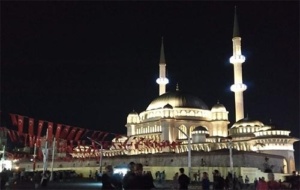 Getting lost was actually really nice because it made me very aware of my surroundings. The ezan (call to prayer) which sounded from the minarets of the Taksim Mosque at that very moment was an absolutely indescribable experience for someone who’s never visited a Muslim country before. I bought some delicious food from Vegan Istanbul, a family-owned take-away restaurant that gives a vegan twist to traditional Turkish dishes. Luckily, I did manage to find my hostel Archeo (completely archaeology-themed!) in the end, and spent the rest of my evening enjoying the view on the Galata Tower from my balcony.
Getting lost was actually really nice because it made me very aware of my surroundings. The ezan (call to prayer) which sounded from the minarets of the Taksim Mosque at that very moment was an absolutely indescribable experience for someone who’s never visited a Muslim country before. I bought some delicious food from Vegan Istanbul, a family-owned take-away restaurant that gives a vegan twist to traditional Turkish dishes. Luckily, I did manage to find my hostel Archeo (completely archaeology-themed!) in the end, and spent the rest of my evening enjoying the view on the Galata Tower from my balcony.
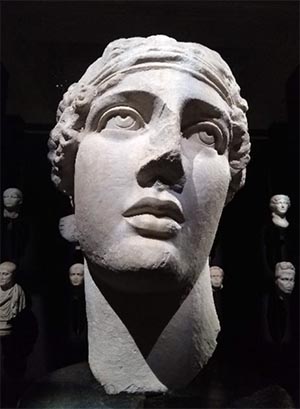 Tuesday 20 September
Tuesday 20 September
I had an early morning to make the most out of my one full day in Istanbul. Instead of taking the tram from my hostel to the Archaeological Museum, I decided to walk, and the stunning views from the Golden Horn bridge didn’t make me regret this. The Archaeological Museum included highlights such as the Alexander sarcophagus, a head of Sappho, a statue of Hadrian from Hierapytna, finds from the Oxford/New York excavations at Aphrodisias, as well as some finds from Troy. Sadly, the section of the museum that houses Oriental art is currently being renovated, so I didn’t see the famous Babylonian glazed brick reliefs. Afterwards, I went to Sultanahmet Square where I saw the horribly long queue for the Hagia Sophia. I hesitated a little whether I wanted to join the queue, but it was oh so worth it. It’s quite hard to put into words the feelings that overcame me when entering this iconic building which is so full of history. I was in complete awe of its massive size, the rich golden decoration and the innumerable chandeliers. The feeling of the soft carpets beneath my feet (it’s compulsory to take off your shoes before entering the building) somehow enhanced the out-of-body experience. Next, I joined yet another long queue for the Basilica Cistern, which was equally very much worth it. I had seen some pictures of this cistern in my guidebook, but nothing could prepare me for the vast columns (two of which have an upside-down head of Medusa as their base) and the haunting play of light on the water. Then I saw the Hippodrome with the Egyptian Obelisk, Serpentine Column and Brazen Column before heading over to the Burnt Column and Grand Bazaar. Unsurprisingly, I got completely lost in the spiderweb of alleyways, but this made my souvenir shopping all the more adventurous. The smell of coffee and spices that dominates the Grand Bazaar made me want to try out a traditional Turkish coffee, which is prepared in a cezve with lots of sugar. Although sceptical at first, I really liked the peculiar taste—luckily, the waiter warned me about not drinking the coffee grounds on the bottom of the cup. I was also given a free cinnamon tea. After some searching, I managed to find my way out of the Grand Bazaar, and walked back to the Blue Mosque, which had been closed to visitors earlier in the afternoon for prayer. Much of the interior of the building is closed off for renovation works, but thankfully I saw the central dome with its innumerable shades of blue. After a long day of sightseeing, I decided to treat myself to the experience of going to the Çemberlitaş Hamamı. The lying down on a marble stone in a domed hot room and the scrub were not entirely pleasant, but the soap wash with massage were much more relaxing. I had dinner at Foodie-Ist, again a restaurant that gives a modern twist to traditional dishes. The view on the Hagia Sophia made the food taste even better. Lastly, I took the tram from Sultanahmet Square to Tophane (where my hostel was located)—witnessing golden hour at the Golden Horn was the perfect end to a perfect day.
 Wednesday 21 September
Wednesday 21 September
I woke up very early, and the hostel receptionist helped me to find a taxi to Esenler Otogar, which is located outside the centre of Istanbul. This was my first encounter with the typical Turkish coach station, which consists of a series of coach operator offices accompanied by squat toilets (in Belgium we call them French toilets, but apparently they’re called Turkish toilets in France). I went into the Pamukkale office, where I waited for my coach to Çanakkale. The four hour-long drive was surprisingly comfortable, and I was even offered free coffee and biscuits. I immediately took a taxi to the archaeological site of Troy. After seeing the replica of the legendary Trojan horse, I climbed onto a viewing platform with impressive views on the site and surrounding area. I was blown away not only by the strong wind there, but also by the size and monumentality of the site. It was such a magical feeling to stand at the centre of so many epic stories (the most famous of which is of course Homer’s Iliad). Troy VI/VII were probably the layers of the Trojan War (if this took place in the first place), and not Troy II/III as wrongly assumed by Troy’s most (in)famous excavator Heinrich Schliemann. He was misguided by the fact that those layers yielded burnt mudbricks, ‘Priam’s Treasure’ and a ramp which he took as the Scaean Gate. Afterwards, I walked to the museum building, of which the height equals the depth of the excavations at the archaeological site. One of the museum’s highlights is the Luwian Seal—its Hittite inscription is the earliest attested piece of writing found at Troy. I lost complete track of time there, so I had to rush to the museum entrance in order to catch the last dolmus (minibus) back to Çanakkale. I stumbled upon a small bazaar on the way to my hotel. I was struck by the large amount of brightly coloured pottery there, and later learnt that Çanakkale has historically been an important pottery production centre. I stayed at the Daffne Otel, a charming boutique hotel in the centre of Çanakkale. In the evening, I saw the replica of the Trojan horse that was used in the Hollywood movie ‘Troy’, and was struck by the width of the Hellespont, which the Persian emperor Xerxes and his army crossed by means of pontoon bridges in 480 BC. It had started to rain by then, so I decided to have dinner at a place called Assos, and immediately went to bed afterwards.
 Thursday 22 September
Thursday 22 September
A horrible mosquito hadn’t stopped pestering me, so I didn’t mind waking up very early. The hotel owner kindly gave me a lift to the coach station, and the traditional Turkish music that was blasting through the radio was more effective than the coffee that I was drinking. The five hour-long coach journey to Bergama went by really quickly—I got to experience what Homer meant by ‘rose-fingered dawn’, and there were some breath-taking views on the Turkish coast and Greek islands. Afterwards, I took the dolmus to the lower cableway station of the Pergamum Acropolis. I was very impressed by the highly modern infrastructure, and hadn’t expected to have my first cableway ride ever in Turkey. The views from the cabin were absolutely spectacular, and the silence at the top was deafening compared with the hustle and bustle of Bergama. The Acropolis of Pergamum (which was a particularly important city in the Hellenistic and Roman periods) definitely ranks among the most impressive sites that I have ever been to. The two highlights are the well-preserved architectural elements of the Temple of Trajan and the theatre that was built into the hillside. The latter was the steepest theatre of the ancient world, so I was very exhausted after my descent and ascent of it. However, the rather sorry state of the Altar of Zeus made it easy to forget that this structure has yielded some of the finest Hellenistic reliefs (now in Berlin). Having taken the cableway back down, I first went to see the Red Hall Basilica before going to the Archaeological Museum, which was quite small but nevertheless houses some interesting inscriptions. Then, I hopped into a taxi to the coach station of Bergama, where I ate a delicious simit (a Turkish ‘bagel’ with sesame seeds). The coach drive to Ayvalık took just less than an hour. After some communication problems with the taxi driver, I arrived at the Kidalyo Hotel—another very nice boutique hotel with extremely friendly staff. I had dinner at Villa Pietra across the street of my hotel, where I discovered my love for fava (a Turkish bean puree). The sea-side location of the restaurant and the sunset were the perfect end to my last full day in Turkey.
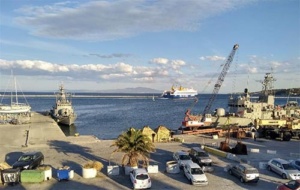 Friday 23 September
Friday 23 September
I really enjoyed this trip’s first night of more than five hours of sleep. When I entered the reception area of the hotel to check out, it was a nice surprise to find coffee and cupcakes waiting for me there. I came across a very pretty mural of Atatürk on my way to the TURYOL office, where I got my boat tickets from. I paid the harbour tax, passed through security and border control, and went aboard the ship to Mytilene. At that point, I felt melancholic to be leaving Turkey, but I was also excited about going back to Greece after three years. I sat on the upper deck of the ship, where I enjoyed the views on Turkey and Lesbos. Very fittingly, I also read some chapters in ‘After Sappho’ by Selby Wynn Schwartz—a recently published book, which acted as my travel companion. Having arrived at Mytilene, I dropped off my bags at the Harbour Loft, a studio that I had rented for two nights with stunning views on the harbour of Mytilene. For lunch, I had an amazing sandwich with locally produced honey (which I managed to spill all over my Univ tote bag). The rest of my afternoon was spent on exploring Mytilene. As a massive Sappho fan, I particularly liked the Sappho mural and statue there. I had some trouble finding the Archaeological Museum, but suddenly realized that I could use Google Maps again without incurring exorbitant roaming costs. The museum has an impressive collection of mosaics from Roman houses in Mytilene, and I also saw a striking funerary relief featuring a female rider (normally such funerary reliefs show male riders). Next, I tried to find the entrance to the Castle of Mytilene (one of the largest fortresses in the Mediterranean), but I sadly didn’t succeed in my mission. Instead, I made a nice walk around the castle, and saw the local Statue of Liberty. I had dinner at NAN, a restaurant that employs refugees in order to help them integrate into Greek society. Due to its location near the Turkish coast, Lesbos was flooded with refugees at the height of the migrant crisis—the name of the refugee camp at Moria may perhaps ring a bell. It’s quite easy to get lost in the beauty of a country when you’re on holiday there, but this was a good reminder of the still ongoing humanitarian crisis in Lesbos.
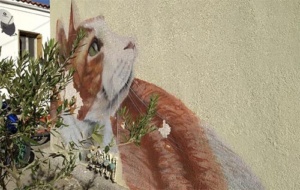 Saturday 24 September
Saturday 24 September
I had been really looking forward to this day for a long time, since I was finally going to visit Sappho’s birthplace Skala Eresos. The sole bus going there that day only left in the early afternoon, so I decided to go for a long run in the morning. The temperature of about 20°C and light sea breeze made this a very enjoyable experience, and I managed to see some parts of Mytilene that I hadn’t been able to visit the day before. The inscription ‘Close Moria! Smash fascism’ painted in massive letters on the outside of an abandoned factory building was another reminder of the island’s dark side. The coach drive from Mytilene to Skala Eresos took slightly less than three hours. Both towns are located on opposite ends of the island, and it was striking to see the sudden change from the greener landscapes of the eastern side to the volcanic landscapes of the western side. Sadly, the Archaeological Museum of Skala Eresos had just closed when I arrived there, so I headed straight to the seaside. The town’s most famous inhabitants, Sappho and Theophrastus, each have their own statue there. It was incredibly special for me to be where Sappho and her ‘circle of women’ had lived, and to see the place that had inspired her to write about the ‘sun’s brilliance’. There were much more cats (including a pretty cat mural) than tourists there. This was clearly related to late September being the end of the tourist season, but also to the fact that Lesbos is probably the least touristy Greek island that I have ever been to, as exemplified by my struggle to find a postcard of Lesbos. I spent the rest of the afternoon swimming in the sea and relaxing at the empty beach with view on the islet in front of the coast, and then had dinner at Food by AJ. Annoyingly, the lack of tourists also meant a lack of buses, which forced me to take a (rather expensive) taxi back to Mytilene.
 Sunday 25 September
Sunday 25 September
I woke up to another ‘rose-fingered dawn’, thinking that the ferry which I could see from my balcony was the one I was about to take. However, when I arrived at the harbour, I realized that my boat to Samos (the Blue Star Ferry Chios) hadn’t arrived yet—it had to come all the way from Thessaloniki. Eventually, my ferry entered the harbour of Mytilene one hour later than scheduled. The spectacular azure blue seascapes and the halfway stop at the island of Chios made the five hour-long journey fly by. On arrival at Vathi (the capital of Samos), I immediately visited the Archaeological Museum. The old part of the museum houses some masterpieces of Archaic Greek art, such as the Cheramyes Kore, the Geneleos Group and the five metre-high Isches Kouros. The new part of the museum has a very fine collection of Greek pottery, as well as lots of objects made of ivory and wood. These easily perishable materials have survived thanks to the swampy conditions at the Samian Heraion, where they have been found. Besides, these objects often show Near Eastern or Egyptian influences, attesting to the central role played by Samos in the sixth-century BC Mediterranean World (something we also learn from the Greek historian Herodotus). I was particularly struck by the room full of locally made bronze griffin heads that had once been attached to cauldrons from the East. Afterwards, I took a taxi to Pythagoreio, where I was going to spend the last three nights of my trip—of course, I had no idea then that my holiday was going to last longer than expected. A very cute cat welcomed me at the entrance to my hotel Acropol. I read some chapters in my book at my balcony with sea view, and then tried to find a nice restaurant by the harbour. I ended up at Enhorio, where I ate a delicious vegan moussaka, and did some souvenir shopping in the main street of the town afterwards. Samos was the only place of this trip that I had been to before, and I must admit that it really felt like coming home.
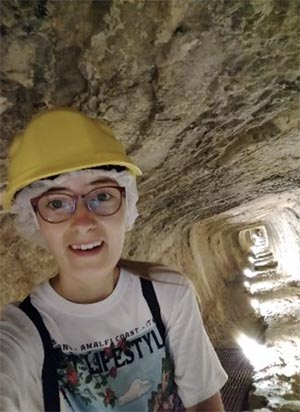 Monday 26 September
Monday 26 September
I rented a bike for two days, and immediately cycled towards the Heraion (Sanctuary of Hera), which is located in the same plain as Pythagoreio, and was once connected to the town by the Sacred Road. The cycle route along the sea had some impressive views on the Turkish Mount Mycale, where the Battle of Mycale took place in 479 BC, which (alongside the Battle of Plataea) ended the Persian invasion of Greece. The Sanctuary of Hera is an incredibly fascinating site, and its most iconic feature is a single colossal upright column. The latter was originally twice(!) as high, and belonged to the Temple of Hera built by the famous Samian tyrant Polycrates. I had a really interesting chat with a Greek guy who is currently doing his MA thesis on the relationship between the Archaic altar and the Roman reconstruction of it. Afterwards, I cycled uphill to the Tunnel of Eupalinos, a sixth-century BC aqueduct that was dug from both ends of a mountain. Visiting this masterpiece of engineering was a highly unique experience, but I wouldn’t recommend it to people with claustrophobia (they even make you wear a safety helmet). Then, I went to the nearby Moni Spiliani monastery with its typically Greek white-and-blue buildings, stunning views and chapel located inside a cave. My efforts of cycling uphill were rewarded by the feeling of absolute freedom I got from cycling downhill to the Archaeological Museum—I did stop halfway through to see the ruins of the ancient theatre. The Archaeological Museum has a good collection of Greek pottery as well as marble statuary (including the Stele of Diagoras), and the outside area features the remains of the ancient town. Samos’ most famous inhabitant Pythagoras is honoured by a statue with a reference to his theorem by the seaside. Besides, most souvenir shops sell so-called ‘cups of Pythagoras’, which completely empty their content when filled with too much liquid—if you want too much, you will lose it all. I felt really tired after a week of travelling around, so I decided to have an early night after having dined at Ariston, another really nice restaurant by the harbour of Pythagoreio.
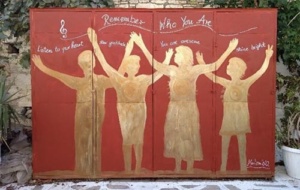 Tuesday 27 September
Tuesday 27 September
My original plan for this day had been to visit Ephesus, but sadly my boat to Kuşadası got cancelled a couple of days before (an omen of what was about to happen with my flights). Despite the close proximity between Samos and Kuşadası, I failed to find another boat because the tourist season had really come to its end. Instead, I decided to have a rather relaxed day, and explore Pythagoreio further. First, I walked to the end of the harbour mole, which was in fact built on top of the massive Archaic harbour mole. Then, I headed towards the so-called Blue Street, a very picturesque alleyway full of floor and wall paintings made by local artists. I particularly liked the reference to the Pythagorean theorem. Nearby was a statue of Lykourgos Logothetis (a Samian freedom fighter in the Greek War of Independence from Ottoman rule), a beautiful church and a small castle. Strikingly, the latter re-used ancient architectural elements such as columns. The walkway alongside the castle had a great view on the runway of Samos Airport, and I saw two airplanes taking off. When I went back to my room to fetch something, I met the mother of the hotel owner. I had a really nice chat with her, and she told me that she had made the classically inspired mosaics hanging on the walls of the corridors—a local archaeologist had taught her the craft. Afterwards, I cycled to a nice beach not so far outside Pythagoreio. I had a swim in the sea, but left soon afterwards because it was simply too cloudy and windy. From there, I cycled to the village of Chora, and decided to go back to Pythagoreio for dinner as it had started to thunder. I had some tzatziki and an incredibly tasty Samos salad, which was basically a Greek salad with local vegetables and feta, at a place called 83100 (the postcode of Pythagoreio). I concluded my last full day in Greece with an enjoyable stroll around the town.
 Wednesday 28 September
Wednesday 28 September
I woke up to a dramatic grey sky, feeling really sad that my trip had almost come to an end (or so I thought). I took a taxi to the airport, and was going to fly to Brussels via Munich. However, I couldn’t find my Lufthansa flight to Munich on the departures schedule. It turned out that my flight had already been cancelled in late August, but I had never been informed about this. The airport staff was rather unhelpful in trying to find a good alternative, and literally all flights seemed to be already fully booked. I nevertheless managed to stay calm, and booked a Volotea flight to Venice for the same day and to Brussels for the next day. What follows is technically no part of my Roger Short trip, so I will only give a brief overview. I actually felt really excited about my visit to Venice because I had never been there before. My flight arrived at the Marco Polo Airport in the late afternoon, and then I took a bus to Piazzale Roma and a boat to Ponte di Rialto. I got lost in the absolute maze of streets, but eventually found my hostel Foresteria Sociale. In the evening, I visited the San Marco Bell Tower, drank an amazing but terribly expensive cappuccino at Florian (the most famous café of Venice), and ate gnocchi at a restaurant called Da Celio. The next morning, I woke up early to go for a run, which allowed me to see some parts of the city that I would otherwise not have had the time to go to, such as the Ponte dei Sospiri and the Accademia. Afterwards, I managed to visit the Museo Correr, Archaeological Museum, Biblioteca Nazionale Marciana, Basilica San Marco and Palazzo Ducale. Then, I took a bus to the Treviso Airport, from where I was going to take a Ryanair flight to Brussels Charleroi. Ten minutes before the scheduled boarding time, however, this flight got cancelled as well. This time, I couldn’t really stay calm—there was a complete chaos, and we were sent from one place of the airport to the other. I ended up booking a flight for very early the next morning, but I had to get from Treviso Airport to Marco Polo Airport, so I also booked a single room in the Hotel Venice Resort Airport, to where I took a taxi. My Brussels Airlines flight left one hour too late, but I was extremely relieved to arrive home safely after two cancelled flights.
Epilogue
I have travelled to Greece about fifteen times in my life, so I naïvely assumed that Turkey couldn’t really be that very different. Unsurprisingly, I was wrong. Thus, these are the things that I wish I had known before travelling to Turkey for the first time:
• I knew about the strong sense of nationalism current in Turkey, but I hadn’t expect to see that many representations of Atatürk and flags of Turkey.
• Culture shock is perhaps too strong a term, but the imposing sight of mosques and penetrating noise of the ezan took some time to get used to for someone who had only been to predominantly Christian countries before.
• Even in Istanbul, very few Turkish people are fluent in English. Luckily, a combination of basic English, hand gestures and German (which Turkish people seem to be more familiar with than English) helped me to communicate with the locals.
• I was struck by the disproportionately large number of men working at hotels, restaurants and shops.
• As a female solo traveller, I had been worried about unwelcome male behaviour. However, I didn’t have a single negative experience. Quite on the contrary, all the Turkish men that I met were extremely friendly and helpful. Of course, this doesn’t mean that I would be any less cautious in the future.
• The squat toilets were not always the most enjoyable experience. I will definitely add more squats to my workout before travelling to Turkey again in the future.
As for Greece, I hadn’t really realized the significance of September being the end of the tourist season. On the one hand, it was great to have the archaeological sites, museums and beaches all for myself. On the other hand, however, it was sometimes far from easy to travel to places by public transport (there are far more buses and boats in July and August), especially because I cannot drive myself. Renting a bike was a cheap solution in Samos because of the relatively small size of the island, but the long distances in Lesbos nevertheless necessitated me to spend quite a lot of money on taxis.
Lastly, I would like to express my sincere gratitude to the Roger Short Memorial Trust for funding my trip to Turkey and Greece, which was a highly enriching experience in both the academic and personal sense. I managed to see a large number of famous archaeological sites, but also learned to deal with the flipside of travelling (i.e. my cancelled boat and flights) in a more mature way. I was meant to undertake this trip two years ago, but then COVID-19 of course hit. However, the delay of two years has made it the perfect conclusion to my time at Univ (I have just graduated from the MSt in Classical Archaeology). Another rather unexpected turn of events was that my friend Lucie could sadly no longer accompany me due to unforeseen circumstances. This trip thus became my first substantial solo trip, and it was an absolutely liberating experience.
Read Leonie’s RSMF travel report (including many more pictures) as a PDF.
Find out more about the range of travel grants and scholarships available to assist Univ students on our Travel Grants page or read further travel reports.
Published: 27 January 2023
